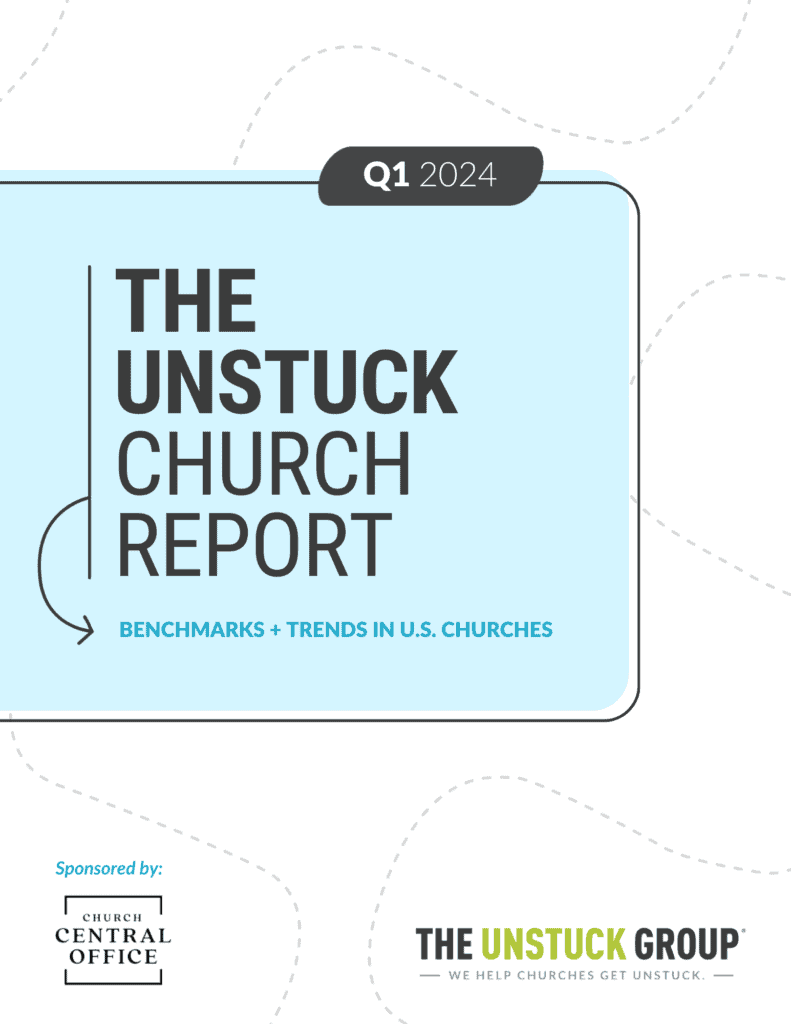Download the Q1 2024 Unstuck Church Report
Every quarter, The Unstuck Group compiles all the data we’ve collected to monitor trends in churches in the United States. For this quarter’s report, we only included churches that provided data between January 8 and February 3, 2024.
We received survey responses from 355 churches, ranging from under 100 to over 10,000 in physical attendance for worship gatherings. The average in-person attendance of churches that participated was 870 people. This provides a very current snapshot of ministries of all shapes and sizes.
“Jesus-Centric” Churches: My Findings from the Q1 2024 Unstuck Church Report
Unfortunately, many churches focus more on “doing church” than “being the church.” As a result, ten percent of the churches that responded to this quarter’s survey had no decisions to follow Jesus in the last 12 months. No salvations. No baptisms. No one saying “yes” to Jesus.
I decided to compare the churches that see a higher percentage of people making decisions to follow Jesus with those that see a smaller percentage. In the first group, I included churches that saw more than 10% of their average weekly attendance cross the line of faith in the last 12 months. In the second group, I included the churches that had 5% or less of their average weekly attendance make decisions to follow Jesus in the last year.
Though the churches were, on average, similar in size and both groups included churches ranging from less than 100 people in attendance to more than 10,000, there were also some significant differences. Here are some of the key questions this analysis raised for me:
- Are denominational ties creating barriers to health? The churches with more decisions to follow Jesus were 40% more likely to be nondenominational.
- Does church governance complexity create unnecessary constraints? Churches with fewer faith decisions had more complex governance structures, including bigger boards and more committees. Giving more people a vote in ministry decisions does not help the church experience more health and growth.
- Can we encourage more churches to leverage a multisite strategy? The churches seeing more people say “yes” to Jesus were almost twice as likely to be multisite churches. That indicates their commitment to multiplication, including reaching more people for Jesus.
- Are churches focused enough on reaching younger families? The churches with more people making faith decisions were reaching younger families with a higher percentage of kids and students. Very likely, the kids and students made many of those faith decisions.
- Can we increase online engagement? The churches with more people crossing the line of faith had more than four times as many people watching services online. This certainly helps confirm that online is a front door for people connecting with faith and the church for the first time.
- Is overstaffing impacting more than financial health? The churches with fewer faith decisions had 40% more staff and spent more of their budget on paid employees. You read that right: Having more paid staff correlates with seeing fewer people meet and follow Jesus.
- Do all those new believers give less? The answer is yes. Per capita giving was 30% higher in the churches where fewer people are making decisions to follow Jesus. However, overall, giving in those same churches had declined year over year. On the other hand, the churches seeing more people say “yes” to Jesus experienced a 10% increase in year-over-year giving. How can that be? That leads to my next question.
- Does this focus on helping people say “yes” to Jesus impact attendance? I can’t prove it. But there’s certainly a correlation. The churches experiencing more people crossing the line of faith were growing twice as fast as those with fewer faith decisions.
This quarter’s data has helped reset my real purpose for offering these quarterly reports: I want to increase the number of lives impacted by Jesus-centric churches. There’s a lot more that we will cover in this quarter’s report, but I hope you find this summary both encouraging and challenging.
Get Your FREE Copy of The Q1 2024 Unstuck Church Report

This quarter’s Unstuck Church Report consists of 20 metrics that highlight trends with an impact on church health. We focus on 4 key areas to give you benchmarks and an objective look at where the Church may be headed:
- Ministry Reach
- Ministry Connection
- Ministry Staffing & Structure
- Ministry Finances
The report also features updated data on the church lifecycle, a summary of the data by church size, and additional insights from report sponsor Church Central Office.
Subscribe today and get The Unstuck Church Report for free each quarter:






